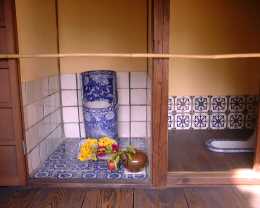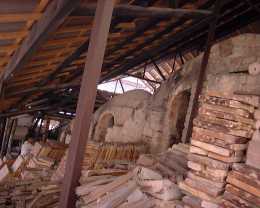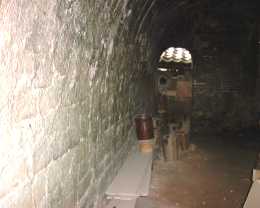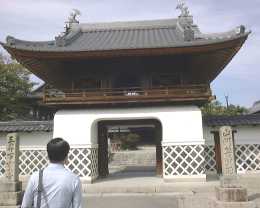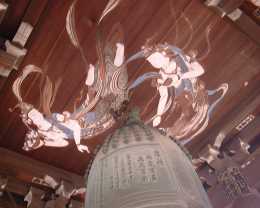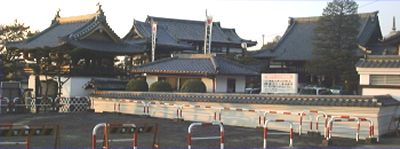注5 窯垣の小径
窯垣とは登り窯や石炭窯で陶器を焼くときに、陶器を保護する為や効率的に窯の中へ
陶器を詰め込む為に使用し、廃材となったエンゴロ、ツク、タナイタ等の窯道具で作った
塀や壁や石垣の総称で、瀬戸市の随所で見ることが出来ます。 窯道具は焼くたびに、
色が付いたり、ヒビが入り廃材となります。窯垣の幾何学模様や人為的でない自然釉の
色合いは人々の目を楽しませてくれます。
注6 本業窯
江戸時代後期に瀬戸では磁器の生産が始まり、産業として有力となってきましたが、
それまでは陶器生産が主たる仕事であり’もともとの仕事’で’’本業’と呼び、
磁器生産の仕事は’新しく入ってきた仕事’で’新製’と呼び分けました。
本業窯とは陶器を焼く登り窯のことで、主に水がめ、すり鉢、こね鉢を焼成していた。
洞にある本業窯は4連房のもので、昭和50年代半ば迄実際に使われていました。
洞には本業窯のほかにも陶芸作家所有の穴窯が多数あり、年に数回焼成されています。
注7 本業タイル
明治時代、日本で洋風建築が流行すると、’敷瓦’(注8)を前身とする本業タイルが
盛んに使われるようになりました。 本業タイルは転写技術の向上により同一図柄で
量産された我国近代タイルの第1号というべきものでした。 本業タイルは本業の
伝統的な調合による土を使い、土の表面の粗さを覆うために磁器の土を使って表面が
化粧してあり、銅版転写による図柄の美しさとも相俟って、陶器でありながら、あたかも
磁器のように繊細で硬質感と近代感を兼ね備えた物となっています。
本業タイルの全盛は明治、大正時代と続きましたが、昭和に入ると硬質磁器タイルや
磁器タイルにその地位を奪われ、衰退の道を辿りました。 窯垣の小径資料館には
浴室及び便所に当時のままの姿で本業タイルが貼り付けてあり、資料としても貴重です。
注8 敷瓦
本業タイルの原形ともいうべき’本業敷瓦’は瀬戸市の古刹’定光寺焼香殿’で見る
ことが出来ます。 (注の出典:’窯垣の小径資料館’のパンフレット他)
Note
5 Kamagaki-no-komichi (or Pathway of fences consisting of tools used during
the firing of ceramic)
Kamagaki-no-komichi
pathway is about 10 minutes walk from Hosenji Temple
and continues for about
400 meters. This winding pathway is fondly remembered
sceme and famous for its
beautiful mosaic patterned walls and fences.
Ceramic making kiln
equipment or tools used in the firing process such as
Engoro
(container to pack the
ceramics), Tsuku (shelf supports) or Ebuta (shelf for
placing the ceramics)
become defunct as time goes on. Such defunct tools inlaid
into walls and fences can
be seen in various parts of Seto city and along the
pathway of
Kamagaki-no-komichi . Geometric pattern or tint of
natural glaze
of such inlaid tools
attract the passersby.
Note 6 Hongyo-gama (or Hongyo-kiln)
The producing of porcelin
in Seto has started from the latter half year of
Edo era (in 1700's) and
become conspicuous as an industry. Until then, the
producing of pottery has
been principal work or job and called as 'Hongyo' or
original business. While
the producing of porcelin has been new-comer and
called 'Shinsei' or newly
coming business.
Hongyo-gama is like
climbing kiln because it is constructed on the slope of
a hiill to fire pottery
such as water jar or water bowl. Hongyo-gama kiln in Hora
area is a kiln with 4
consecutive cluster and was used in practical manner
until the mid 1970s. Only
two Hongyo-gama kilns remain in Seto city today.
Both
'Ichirizuka-Hongyo-gama' and 'Hora(Seto)-Hongyo-gama' are
designated
as tangible cultural
properties. There are many Ana-gama kilns (cave-shape
kiln)
owned by ceramic artists
in Hora area where ceramics are fired several times
a year.
Note 7 Hongyo-tile
When a Western-style
building became popular in Meiji-era (1868-1911)
Hongyo-tile which
originated in 'Shikigawara' (See Note 8) ware used extensively.
Hongyo-tile would be the
first modern tile in Japan mass-produced with
same design or pattern
thanks to the improvement of transcription technology.
Hongyo-tile uses clay
prepared in production of pottery or original
business,
and the surface is made up
by clay for porcelain to cover roughness of pottery
surface. Combined with
beauty of pattern thanks to copperplate transcription,
Hongyo-tile is ,although
pottery, delicate like porcelain and has both feeling of
hardness and modernity The
golden days for Hongyo-tile were Meiji and
Taisho era (1868 to 1925)
and since 1925 (beginniing of Showa era) Hogyo tile
were replaced with hard
quality porcelain tile gradually and declined.
The privy and bathroom is
preserved in same state they were used in the
past at
Kamagaki-no-komichi museum and Hongyo-tiles are put on
the privy
and bathroom which are
considered very valuable.
Note 8 Shikigawara (roofing tile)
Hongyo-Shikigawara(roofing
tile) is said to be the original shape of
Hongyo-tile and can been
seen at the incense-burning hall
of Jyokoji temple
in Seto City.
[source] Pamplets or brochures of
'Kamagaki-no-komichi museum', or others
|


